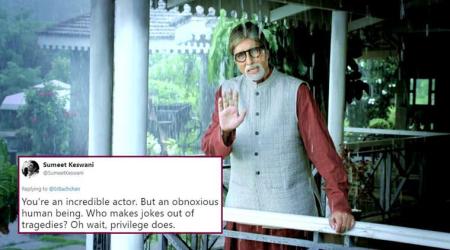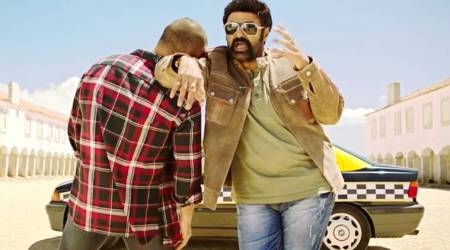 Aishwarya Rai-Bachchan with daughter Aaradhya Bachchan at IFFM 2017. Rai-Bachchan hoisted the Indian flag at Federation Square to mark India’s 70th Independence Day celebrations.
Aishwarya Rai-Bachchan with daughter Aaradhya Bachchan at IFFM 2017. Rai-Bachchan hoisted the Indian flag at Federation Square to mark India’s 70th Independence Day celebrations.
When you hear that Melbourne is one of the most liveable cities, believe it. I am in the cultural capital of Australia to catch as much cinema and as many filmmakers as I can, and I amass plenty of movies and chat, but what I come away with is, overwhelmingly, just how nice the people are, and how engaged they are with the happenings in their city.
There is, literally, a problem of plenty during these three August weeks when both the Indian Film Festival of Melbourne (IFFM, 10-22 August) and the Melbourne International Film Festival (MIFF, 3-20 August) run, practically concurrently.
The programming at both festivals is sharp and eclectic, and provides for a wide cinematic range, from the auteur-indie to the popular. At MIFF, there are films from the Berlinale and Cannes (the searing I Am Not Your Negro from the former, and The Square, which won the Palme D’Or) and other top festivals, Australian classics and premiers, and retrospectives.
At IFFM, a clutch of Bollywood crowd pleasers — Dangal, Badrinath Ki Dulhania, M.S. Dhoni: The Untold Story, and new Bollywood films like Trapped and A Death In The Gunj are offset by an impressive section called “Beyond Bollywood”, which includes Lipstick Under My Burkha (which opens the festival, with director Alankrita Srivastava and actor Konkona Sen Sharma in attendance), Bahubali, parts 1 and 2 ( producer Shobu Yarlagadda is at hand), Doctor Rakhmabai (lead actress Tannishtha Chatterjee is there; Marathi), Joker ( which comes riding on rave reviews; Tamil), Loktak Lairembee (global festival hit, Manipuri), and several others, all of which look inviting.
I have only four days in Melbourne, and they pass by in a blur, crammed with meetings and screenings and catching up with film people. My wish-list is impossibly long, but I manage to luck into a bunch of solid Australian films, all reflecting the continent’s multi-cultural ethos: Ali’s Wedding, a not madly original but funny and true rom com about a first-gen immigrant adapting to his country’s way; Three Summers, a perceptive, generational medley of Oz manners; and Westwind: Djalu’s Legacy, a telling exposition of indigenous talent and how it survives in the face of globalisation.
One of the main reasons for my being on a cinema tour in Australia (facilitated by the Australian High Commission in Delhi) is to observe the connections between Australian and Indian cinema, and where cinema from Australia is at, globally.
There was a time when cinema from Australia was on the radars of film-lovers around the world. Remember the chilling mood piece Picnic At Hanging Rock (1975; directed by Peter Weir), about three students and a teacher who disappear? That film and its delicate, simmering mystery still haunts me. A decade later, there was the cheesy but supremely entertaining 1986 Paul Hogan starrer Crocodile Dundee, featuring an eccentric crocodile-catcher and scaly reptiles in the Australian Outback. It was an international hit, but its sequels didn’t work as well.
There really hasn’t been an equally huge international Australian success after that, till last year’s Lion. Directed by Melbourne resident Garth Davis, and starring Oz star Nicole Kidman, British-with-Indian-lineage Dev Patel, the elfin-faced Rooney Mara, and the charming Indian child actor Sunny Pawar, the film has been on a global march since its release in 2016. The fact that it was nominated for a clutch of Oscar nominations ( Best picture, best supporting acts by Kidman and Patel) didn’t hurt, either.
“Lion is setting new benchmarks,” says Jenni Tosi, CEO of Film Victoria, the Victorian state government screen agency, whose mandate is to support and fund new talent and ideas. Will it reclaim the ground that Australian cinema seems to have ceded in the past couple of decades? “It may not immediately open up the floodgates, because, as you know, films are in development and production for several years. But it has certainly put us back on the world map,” says Tosi, who has been to film festivals and funding events around the world (including India). “And we are now in a better place.”
The thing is that Australian cinema has to compete with the massive budgets that the US and the UK bring to their projects. “We don’t have language to our advantage,” she says, “wherever there are English language films, we are up against the glossiest Hollywood productions, whether it is domestically or internationally. Sometime even foreign films do better locally than our own films.”
As surprising as that might sound, it is true. Aamir Khan’s Dangal has broken into the Top 20 hits, the first time a Bollywood/ Indian film has done so. And there is delight all round, especially among those who are connected with ‘desi’ cinema in Australia. Mitu Bhowmick Lange, who began her ‘filmi’ career distributing Yashraj films, and who also runs the IFFM, has seen the growth first hand in the last 17 years she’s been in Melbourne.
There’s a massive turnout at all the Bollywood events. Aishwarya Rai Bachchan unfurls the tiranga at the Federation Square; Karan Johar’s (ticketed) master-class is a sell-out; Sushant Singh and Rajkummar Rao are mobbed by selfie-demanding fans. But the screenings too are full, even the non-starry arthouse ones.
The challenge for Bhowmick is to spread the reach of the festival. “Big Bollywood extravaganzas will always be crowd-pullers, of course”, she says, “and why shouldn’t we celebrate the colour and joy of our cinema. But at the same time, we are seeing more non-desi audiences at our movies, especially for those films which are truly different, and in other languages from India.”
The commingling of cinematic cultures is a difficult thing, but I do see some evidence of it, especially at the opening night’s screening of Lipstick Under My Burkha, which is a splendid new mould-breaking Bollywood offering. The best part : Tosi and Bhowmick talk to each other, and support each other’s events.
I end my filmi-Oz sojourn at the Fox studios in Sydney. The day I visit, the lots and the stages — some so big that you can get lost, some more human-scaled — are quiet because they are between shoots. Some really big films have been made here, and I see some delicious posters which I immediately want to steal : The Matrix films, Mad Max Fury Road, Pacific Rim 2, Hacksaw Ridge, and one of my favourite guilty pleasures, Baz Luhrmann’s Moulin Rouge.
In the middle of my whistle-stop guided tour in one of those dinky golf carts, I’m asked if I want a keepsake photo. I jump out, and, err, pose.
And that’s a wrap.

